
Etheostoma is a genus of small freshwater fish in the family Percidae native to North America. Most are restricted to the United States, but species are also found in Canada and Mexico. They are commonly known as darters, although the term "darter" is shared by several other genera. Many can produce alarm pheromones that serve to warn nearby fish in case of an attack.
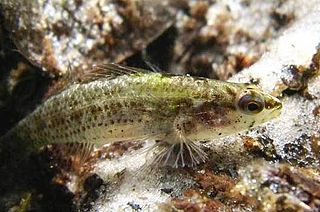
The Okaloosa darter is a species of freshwater ray-finned fish, a darter from the subfamily Etheostomatinae, part of the family Percidae, which also contains the perches, ruffes and pikeperches. It is indigenous to freshwater streams and tributary systems in Okaloosa and Walton Counties in northwest Florida.
The coldwater darter is a species of freshwater ray-finned fish, a darter from the subfamily Etheostomatinae, part of the family Percidae, which also contains the perches, ruffes and pikeperches. It is endemic to the United States, where it occurs in the Coosa River system of Georgia, Alabama, and Tennessee.
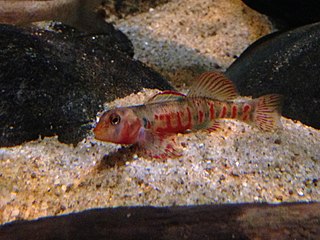
The Kanawha darter is a species of freshwater ray-finned fish, a darter from the subfamily Etheostomatinae, part of the family Percidae, which also contains the perches, ruffes and pikeperches. It is endemic to the southeastern United States.

Etheostoma osburni, the candy darter or finescale saddled darter, is a species of fish in the family Percidae, a member of the group known as darters. This species is endemic to the eastern United States where it is known only from the Kanawha River system in the states of Virginia and West Virginia.

Medionidus penicillatus, the gulf moccasinshell, is a rare species of freshwater mussel in the family Unionidae, the river mussels. This aquatic bivalve mollusk is native to Alabama, Florida, and Georgia in the United States, where it is in decline and has been extirpated from most of the rivers it once inhabited. It is a federally listed endangered species of the United States.
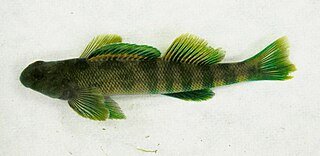
The greenside darter is a species of freshwater ray-finned fish, a darter from the subfamily Etheostomatinae, part of the family Percidae, which also contains the perches, ruffes and pikeperches. It inhabits swift riffles in the eastern United States and southern Ontario.
The golden darter is a species of freshwater ray-finned fish, a darter from the subfamily Etheostomatinae, part of the family Percidae, which also contains the perches, ruffes and pikeperches. It is found in the upper Tennessee River, one of the over 300 fish species found in Tennessee.
The cherry darter is a species of freshwater ray-finned fish, a darter from the subfamily Etheostomatinae, part of the family Percidae, which also contains the perches, ruffes and pikeperches. It is endemic to the upper Caney Fork system of the Cumberland River drainage in the U.S. state of Tennessee.
The saffron darter is a species of freshwater ray-finned fish, a darter from the subfamily Etheostomatinae, part of the family Percidae, which also contains the perches, ruffes and pikeperches. It is endemic to the eastern United States, where it is found in streams and creeks in Kentucky and Tennessee.

The swamp darter is a species of freshwater ray-finned fish, a darter from the subfamily Etheostomatinae, part of the family Percidae, which also contains the perches, ruffes and pikeperches. It is endemic to the Eastern United States.

The greenbreast darter is a species of freshwater ray-finned fish, a darter from the subfamily Etheostomatinae, part of the family Percidae, which also contains the perches, ruffes and pikeperches. It is endemic to the southeastern United States, where it occurs in the systems of the Alabama River and the Black Warrior River. It is an inhabitant of streams and rocky riffles of creeks and smaller rivers. This species can reach a length of 7.9 cm (3.1 in), though most only reach about 5 cm (2.0 in).
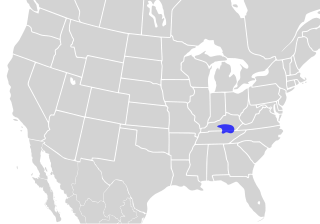
The headwater darter is a species of freshwater ray-finned fish, a darter from the subfamily Etheostomatinae, part of the family Percidae, which also contains the perches, ruffes and pikeperches. It is endemic to the eastern United States where it is found in Kentucky and Tennessee in the upper Green River system down to the Mud River, in the Cumberland River and upper Salt River systems. It is an inhabitant of streams up to about 5 metres (16 ft) wide with gravel or cobble substrates. Males of this species can reach a length of 6.2 centimetres (2.4 in) SL while females only reach 5.7 centimetres (2.2 in). The headwater darter was first formally described in 2002 by Patrick A. Ceas and Brooks M. Burr With the type locality given as Koger Creek, which is in the drainage of the Wolf River, about 0.8 kilometers northwest of Rolan, Kentucky along Kentucky Route 415 at the confluence of McIver Creek in Clinton County.
The goldstripe darter is a species of freshwater ray-finned fish, a darter from the subfamily Etheostomatinae, part of the family Percidae, which also contains the perches, ruffes and pikeperches. It is endemic to the southeastern United States where it is found in Gulf Slope streams from the Colorado River drainage in Texas to the Flint River in Georgia, the Atlantic Slope in Ocmulgee River system, Georgia, and the Mississippi embayment north as far as southeastern Missouri and western Kentucky. It is typically found in small springs, streams, and creeks with aquatic and marginal vegetation and detritus. The female spawns on multiple occasions between about mid-March and June, sticking the adhesive eggs to plants, gravel and the sides of rocks. The goldstripe darter is a common species with a wide range and numerous sub-populations, and the International Union for Conservation of Nature has assessed its conservation status as being of "least concern".

The orangethroat darter is a species of freshwater ray-finned fish, a darter from the subfamily Etheostomatinae, part of the family Percidae, which also contains the perches, ruffes and pikeperches. It is endemic to the central and eastern United States where it is native to parts of the Mississippi River Basin and Lake Erie Basin. Its typical habitat includes shallow gravel riffles in cooler streams and rocky runs and pools in headwaters, creeks, and small rivers, with sand, gravel, rubble, or rock substrates. It forages on the bottom for the aquatic larvae of midges, blackfly, mayfly and caddisfly, as well as isopods and amphipods. Spawning takes place in spring, the selected sites often being the upper stretches of riffles with sandy and gravelly bottoms interspersed with larger cobble. Reproductive success is high in this species. No particular threats have been identified, and the International Union for Conservation of Nature has assessed its conservation status as being of "least concern".
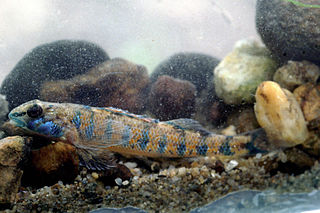
The speckled darter is a species of freshwater ray-finned fish, a darter from the subfamily Etheostomatinae, part of the family Percidae, which also contains the perches, ruffes and pikeperches. It is endemic to the central and southeastern United States. It occurs in the Mississippi River basin and through the Gulf Coast drainages. It is also found in the Clinch River and the Powell River. This species inhabits rocky or sandy pools in flowing waters up to the size of medium rivers with fast currents. It can reach a length of 6.1 centimetres (2.4 in) TL though most only reach about 4 centimetres (1.6 in).
The Cumberland darter is a rare species of freshwater ray-finned fish, a darter from the subfamily Etheostomatinae, part of the family Percidae, which also contains the perches, ruffes and pikeperches. It is endemic to Kentucky and Tennessee in the United States, where it occurs in the upper Cumberland River tributaries above Cumberland Falls. It was federally listed as an endangered species in the US on August 9, 2011.

The greenthroat darter is a species of freshwater ray-finned fish, a darter from the subfamily Etheostomatinae, part of the family Percidae, which also contains the perches, ruffes and pikeperches. It is found in Colorado, Guadalupe and Nueces River drainages in Texas; and in Pecos River system in New Mexico.
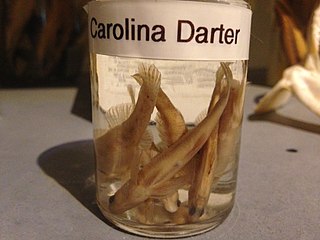
The Carolina darter is a species of freshwater ray-finned fish, a darter from the subfamily Etheostomatinae, part of the family Percidae, which also contains the perches, ruffes and pikeperches. It is endemic to the eastern United States, where it occurs in the Atlantic Piedmont from Roanoke River drainage of Virginia to Santee River drainage of South Carolina. It inhabits muddy and rocky pools and backwaters of sluggish headwaters and creeks. This species can reach a length of 6 cm (2.4 in). The Carolina darter was first formally described in 1935 as Hololepis collis by the American ichthyologists Carl Leavitt Hubbs (1894-1979) and Mott Dwight Cannon with the type locality given as a creek near York, South Carolina.

The Creole darter is a species of freshwater ray-finned fish, a darter from the subfamily Etheostomatinae, part of the family Percidae, which also contains the perches, ruffes and pikeperches. It is endemic to the Eastern United States, where it occurs in the Ouachita, Red, Calcasieu and Sabine River drainages in Arkansas and Louisiana. It inhabits gravel riffles, current-swept vegetation and debris in creeks and small to medium rivers. This species can reach a length of 7.4 cm (2.9 in). The creole darter was first formally described in 1969 by Ray S. Bridsong and Leslie William Knapp with the type locality given as the Dugdemona River, Jackson Parish, Louisiana.














